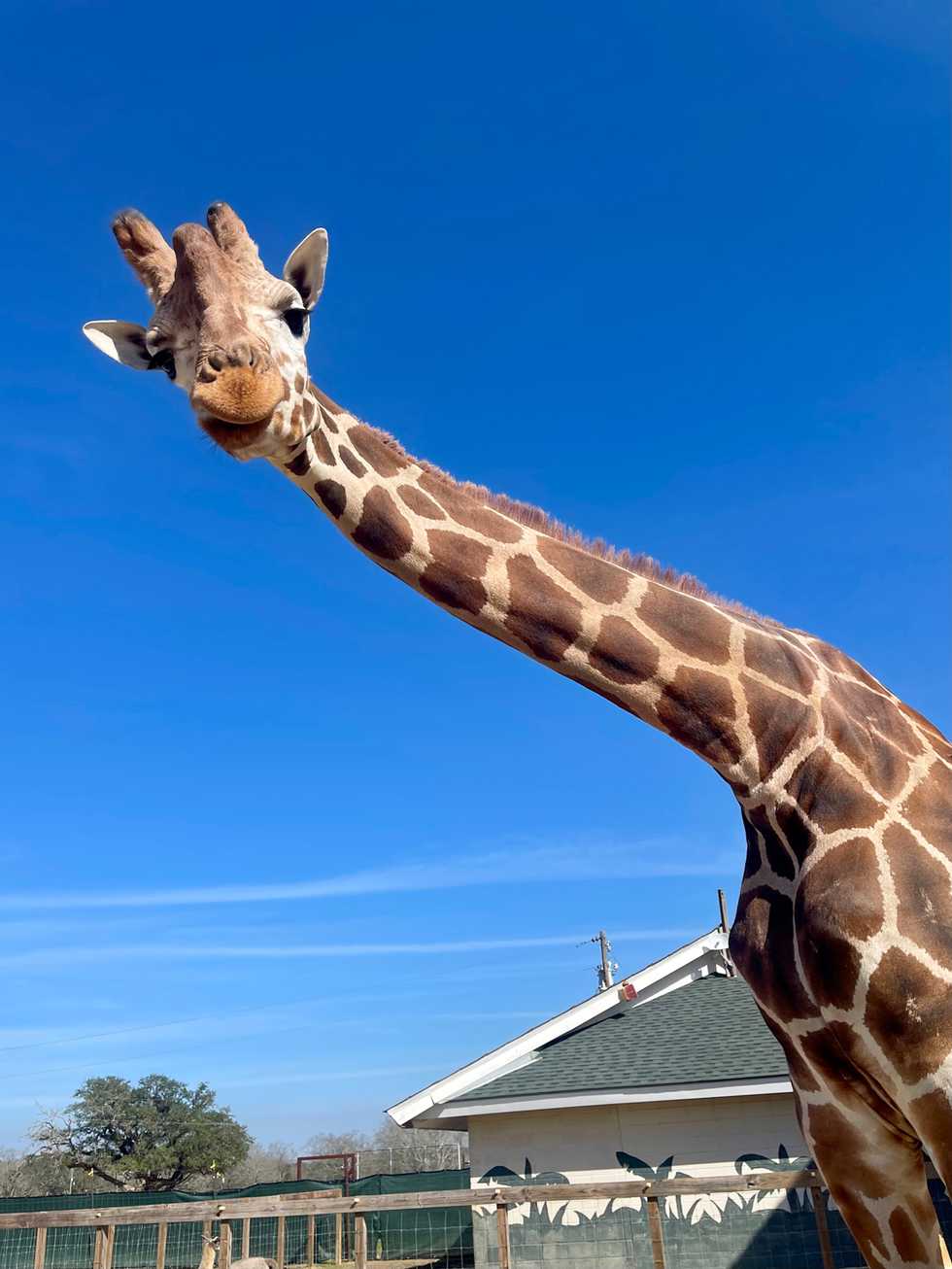
Alexandra Kennon
Global Wildlife Center in Folsom is home to a wide variety of rare and exotic species, including a herd of reticulated giraffes.
Driving through the gates of Folsom’s Global Wildlife Center, the sprawling open landscape stretched beyond as I slowed my car to a stop, allowing a group of fallow deer and a lone rhea to leisurely cross the gravel drive in front of me. Maybe it was simply my inner child of the ‘90s projecting some cinematic drama onto my Northshore safari adventure, but entering the 900-acre park containing thousands of rare animals, I started to hear John Williams’s “Theme from Jurassic Park” playing in my head.
No clones of dinosaurs live here, thankfully—but much like Spielberg’s prehistoric theme park, Global Wildlife Center is home to a wide range of creatures one would never expect to find on that particular plot of land in Tangipahoa Parish. And while the animals here aren’t de-extinct, some species are severely endangered, or have even been brought back from the very brink of extinction.
Among these are reticulated giraffes, Grant’s zebras, Bactrian camels, American bison, various rare species of deer and antelope, and many more—largely roaming free. This model allows the animals to form herds, similarly to the way they would in the wild—except at Global, there are no predators. And each animal enjoys the world-class care of an exotic animal veterinarian, along with a team of local vets on call. Not to mention the admiration of wagon-loads of visitors—there to gain an up-close appreciation and understanding of each species along the way.
When I pulled up at the Visitor's Center, I was greeted by Global Wildlife Center’s Executive Director Christina Cooper, owner/CEO Maci Matherne, and Tours Manager Casey Cousins. We said “hi” to a large male peacock surveying the picnic tables before we hopped into an open-air Pinz.
As the Pinz ambled along the gravel drive and off of it, Cousins’s cheerful voice regaled us with fun facts over the rumbling motor, periodically interrupted by our giggles and coos of delight as various creatures confidently approached, sticking their heads into the open vehicle to greet us and solicit treats from the large feed bag we carried.
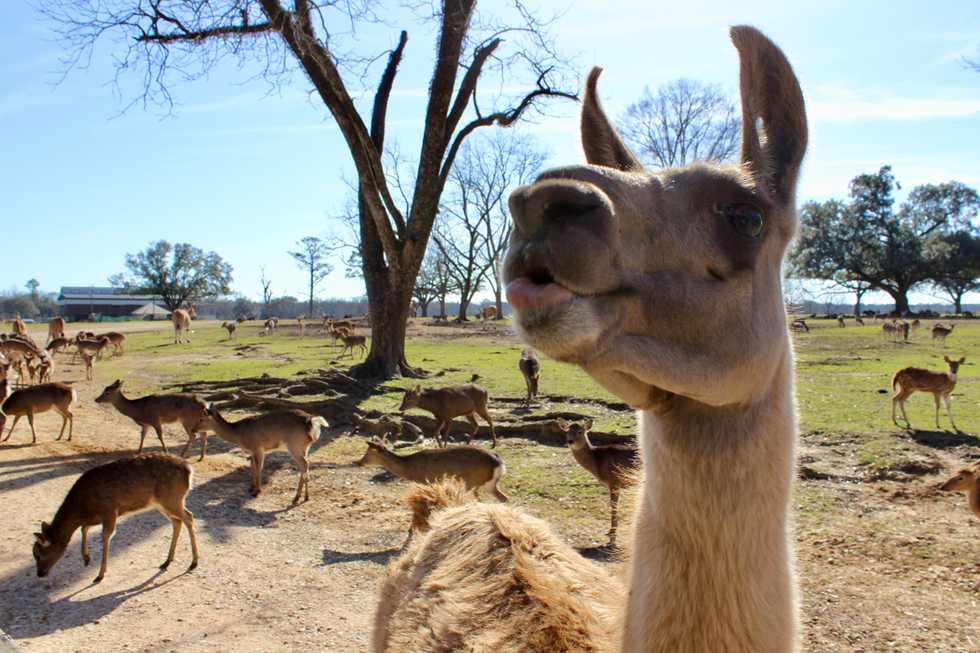
Alexandra Kennon
A llama greeting our tour at Global Wildlife Center.
One of the first things that struck me during the tour was the wide variety of personalities we encountered across each species, and how unhesitant the animals were to show off for visitors. From Dali (a llama), to Winston (a 2,000-pound Holstein cow), to the alpaca Lil’ Red and her mom Farmer Red (known to frequently dangle a piece of straw from her mouth), to Lucy the Watusi (a type of cow originating from East Africa), and on and on—the range of wild residents at the Center (a large percentage of whom have names) is enough to make one’s head spin.
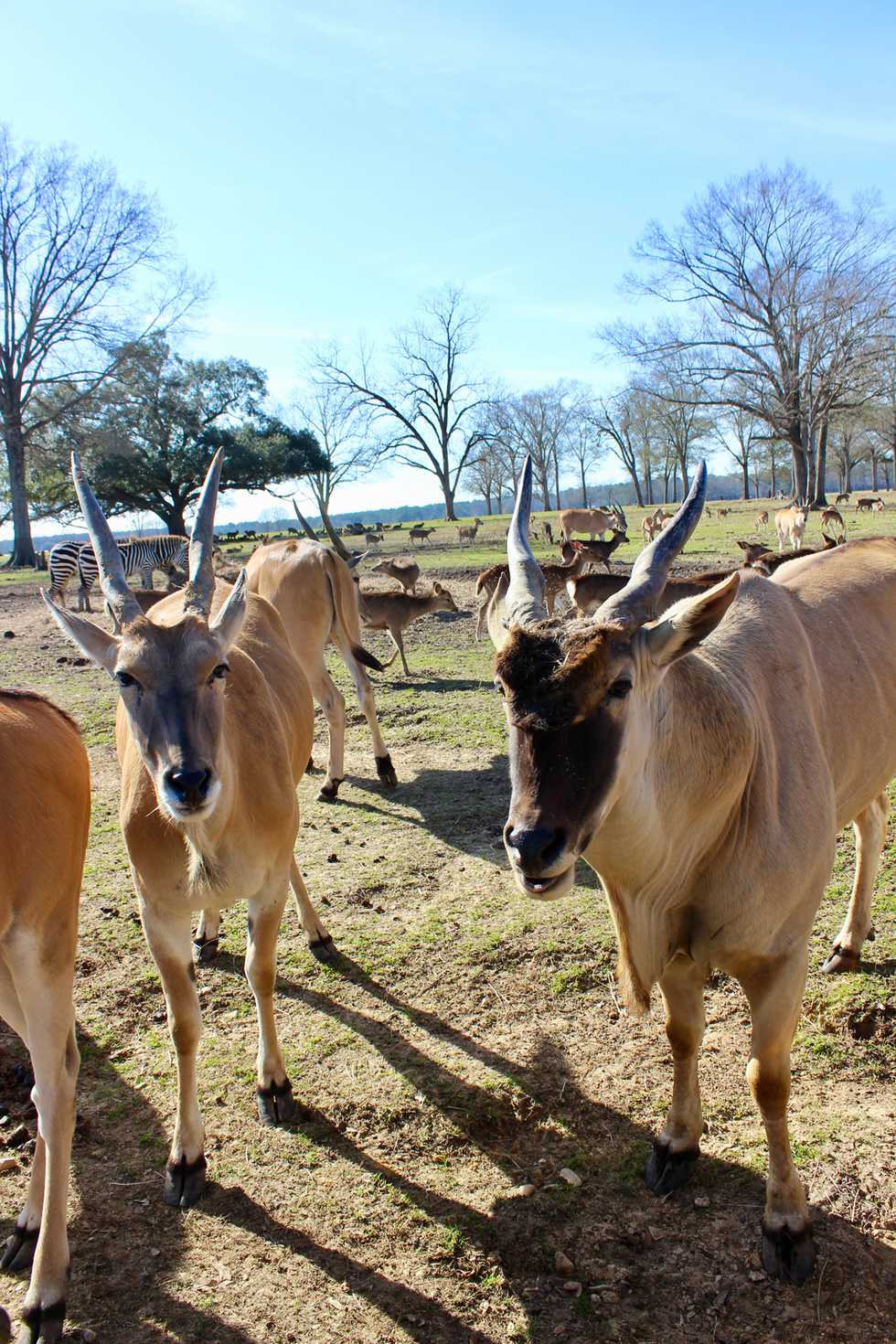
Alexandra Kennon
Cape Eland Antelope at Global Wildlife Center in Folsom.
Beyond meeting the individual animals themselves, on our tour I also gained a trove of new knowledge about these exotic species. I now know, for instance, that llamas have incredibly short tongues, which is why their mouths are cleft in the middle to allow them to pick up food. I learned that the darker an Indian blackbuck’s coat is, the more testosterone the animal produces; that no two zebras have the same coat markings, and that they’re also the only animals at the Center too aggressive to be fed on tours. I learned that lore explains the cross markings on Sicilian donkeys’ backs as remnants from their Biblical role of carrying pregnant Mary to Bethlehem. Giraffes’ tongues, it turns out, are purple for a reason: to act as a natural sunblock as they graze from the tops of trees.
One of the first things that struck me during the tour was the wide variety of personalities we encountered across each species, and how unhesitant the animals were to show off for visitors.
When we pulled up to the giraffe barn, half a dozen female giraffes laid relaxing in the shade, watching us from afar, unbothered. “This is pretty cool,” said Cousins. “You’ll see the giraffes laying down in the grass, relaxing. This is not something that you would typically see them do in the wild. They’re only doing this right here, right now, because we have no predators.” In the wild, giraffes are always on alert for the constant threat of their many predators, and do almost everything standing, including sleeping.
This particular enclave of giraffes seemed to be enjoying the lower stakes, certainly. We dub them “the girls’ club,” laughing. Cooper, Matherne, and Cousins are clearly still not over the wonder that comes with seeing such animals at arms’ length. And as a first-timer to the Center who had only previously encountered such exotic creatures on the other side of zoo enclosures, I found myself overwhelmed with child-like excitement the entire afternoon.
[Read about another local animal refuge, Barnhill Preserve in Ethel.]
“We have Kya, Maci, Keisha, Sara, and little Magnolia,” Cousins gushed, introducing the giraffes before us. Since my visit, another baby giraffe, Amari, was born at the Center in March 2023. “Magnolia is getting pretty big already—she’s about to make two years. They’re born about six feet tall, though.”
At this point, one of the female giraffes, Maci, leisurely stood up and approached the vehicle, her long neck snaking inside to greet us. “She must know Maci’s here,” Cousins laughed, pointing out that the giraffe’s namesake is Global Wildlife’s owner Maci Matherne. “I didn’t name her after myself,” Matherne clarified with a dry laugh. “That was my dad’s doing.”
A New Era
Matherne’s father Ken founded Global Wildlife Center in 1991, when she was a year old. Even having grown up around the Center, she’s quick to say that the proximity to its exotic residents still holds its magic.
Since her father’s passing in the fall of 2021, Matherne’s transition into ownership of Global Wildlife Center has been far from easy. During the last decade under his leadership, the Center had come under serious scrutiny for how it managed the animals’ medical care, among other allegations including racially-exclusive hiring practices and misappropriation of nonprofit funds. Since Matherne has taken over, she and the current administration have gone to enormous lengths to address these issues and ensure Global Wildlife Center is a place she, and the Northshore as a whole, can be proud of.
“The past year and a half has been full of personal challenges because of the passing of my father and our complicated relationship. But the core of Global Wildlife Center’s story is that he created something more than thirty years ago that has brought such joy to me and also to hundreds of thousands of people,” Matherne said. “I am humbled to be able to put my own mark on the Center and take it in a direction that aligns with my personal and professional values.”
Matherne’s first step as owner was to bring Christina Cooper back on as Global’s Executive Director. Cooper started as a tour guide at Global back in 1996 after taking a safari tour—and since then, working at the Center has remained her "dream job”. “I was finishing up my senior year at LSU with a degree in animal science and I commuted an hour each way to earn minimum wage because I loved it so,” Cooper said.
After graduating from college, she went to South Africa to assist with a reproductive studies research project overseen by the Henry Doorly Zoo in Omaha—which made her realize working in a laboratory was not her calling. “For the next fourteen years, I worked nearly every position at Global Wildlife Center and gave my heart and soul to the organization, working tirelessly to help it grow and flourish," Cooper said. "No matter what position I was working, the opportunities to connect with people and children and share a love and respect for wildlife always brought me such joy.”
In 2010, Cooper left the Center to pursue invaluable opportunities in the fields of wildlife rehabilitation and public relations: volunteering at a wildlife rehabilitation center and game preserve in South Africa and serving as education manager at The Elephant Sanctuary in Tennessee, before returning to St. Tammany Parish, where she spent a decade working for the Tourist Commission.
“The life and career experiences I was blessed to have upon my departure from Global Wildlife Center in 2010 have prepared me for this opportunity to return as Executive Director and continue to elevate the organization,” Cooper said with confidence. “I feel incredibly blessed to return to Global Wildlife Center and be supported by Maci, the staff, and the community as a whole to help the Center realize the dreams I established for it from my very first days here. It’s exciting to see projects and initiatives I dreamed of years ago being put into place now.”
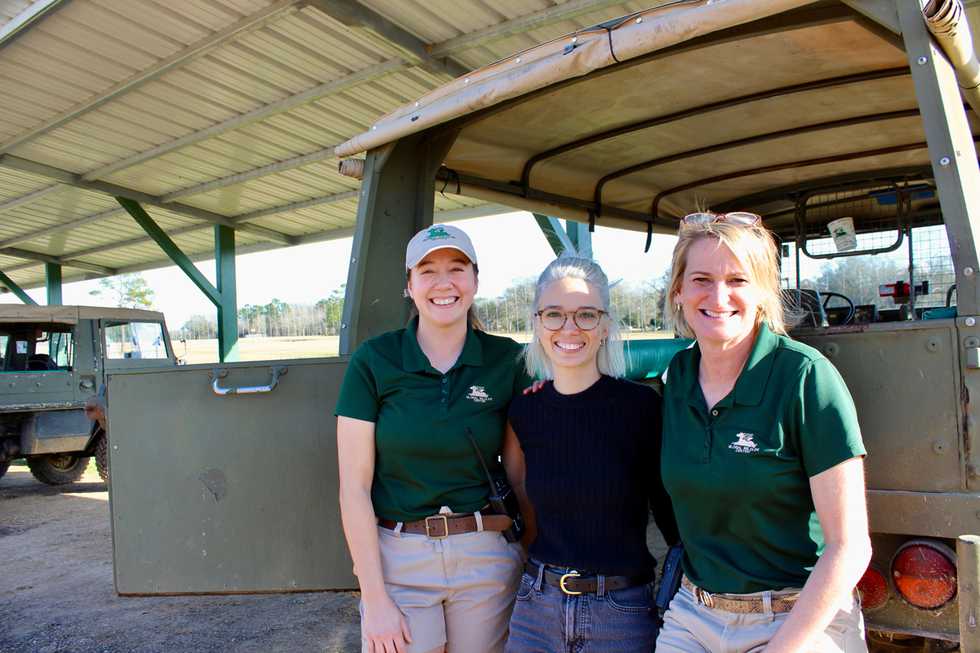
Alexandra Kennon
(Left to right) Global Wildlife Center Tours Manager Casey Cousins, owner/CEO Maci Matherne, and Executive Director Chrisina Cooper freshly returned from a Pinz tour of Global Wildlife Center.
The Foundation’s Board of Directors and Matherne clearly recognize the value of Cooper’s vision. “I mean this wholeheartedly when I say there is no one on this planet besides myself who is more passionate about Global Wildlife Center,” Matherne told me, describing Cooper. “She is an incredibly empathetic and effective leader who has brought our team together in a way I believe is unique to her personality and talents. There is no one I would trust more to continue to make Global Wildlife Center the best version it can possibly be.”
"I feel incredibly blessed to return to Global Wildlife Center and be supported by Maci, the staff, and the community as a whole to help the Center realize the dreams I established for it from my very first days here." —Christina Cooper, Global Wildlife Center Executive Director
Together, Matherne and Cooper are in lock-step as they usher in a more ethical and intentional future for Global Wildlife Center. “Maci is not only brilliant, but she is also socially conscious, possesses a high moral compass, is built of strong character and is a very compassionate leader,” said Cooper of their partnership. “We are committed to investing in excellence for animal care, organization best practices, team development, and supporting local and worldwide wildlife conservation and education.” Led by this vision, the administration at Global Wildlife is currently making its way through a strategic planning process designed to ensure the Center continues to thrive and realize its fullest potential, while having a positive impact on the next generation of conservation enthusiasts.
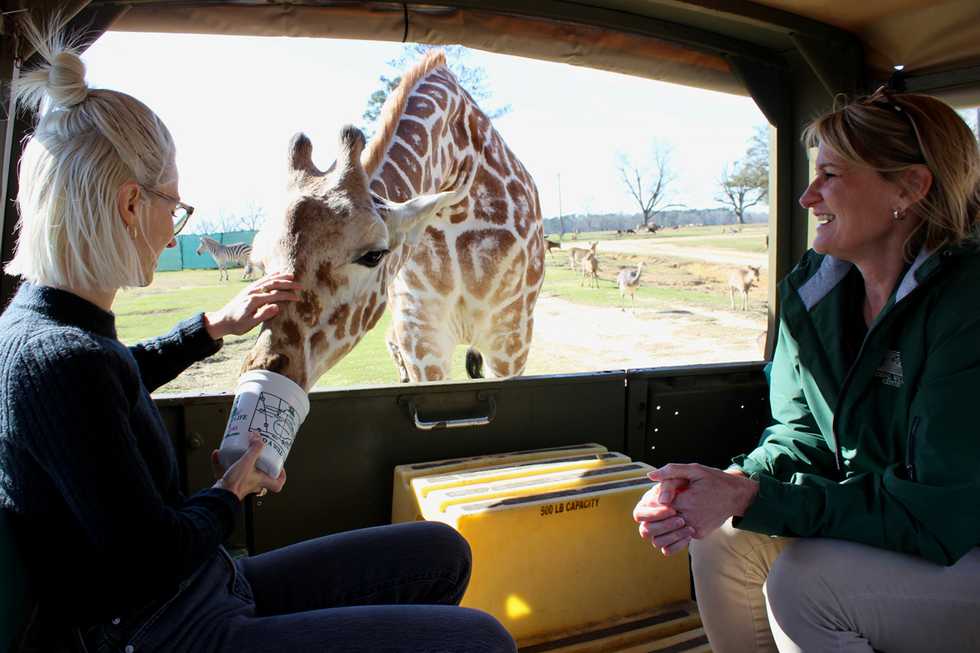
Alexandra Kennon
Global Wildlife Center Owner/CEO Maci Matherne and Executive Director Christina Cooper.
While Matherne believes in a “people first” approach to ensuring a positive work environment for employees and first-class experiences for guests is paramount, running parallel to these priorities is a firm commitment to animal welfare. “Of course, we’re a bit unique in that we also have the great responsibility of housing some of the most amazing animals from all over the world at our facility, and the most comprehensive care for our animals will always remain top priority for me in running the center,” she said. “So, you might say that I have both an ‘animals-first' approach and a ‘people-first’ approach. Both philosophies are incredibly important to me personally, and to the success of this organization.”
Reflecting these ideals, some of the tangible changes made under Global Wildlife’s new administration include actions designed to prevent misuse of funds and increase transparency. As of earlier this year, Matherne and the Global Wildlife Foundation’s Board of Directors officially agreed to separate the Foundation from the Center's operations—recentering the Foundation’s focus to deal solely with philanthropic efforts supporting animal conservation initiatives including wildlife reintroduction, conservation in the wild, conservation education, local animal and educational charities, and minimizing human-wildlife contact.
". . . you might say that I have both an ‘animals-first' approach and a ‘people-first’ approach. Both philosophies are incredibly important to me personally, and to the success of this organization.” —Maci Matherne, Owner/CEO of Global Wildlife Center
Matherne has also committed to contributing a portion of proceeds from the Center’s operations back to the Foundation’s efforts. “That means that in addition to learning and having fun, each guest who comes to Global Wildlife Center will know that they’ve made their own impact on the future of animals, both locally and around the world,” she said. One such example was a $15,000 donation the Foundation made this year toward the Giraffe Conservation Foundation’s efforts in Namibia, with plans for many more such contributions in the future.
Matherne and Cooper have also implemented pay increases across the board for staff, including added bonuses, paid time off, and health care for eligible team members. “I’m committed to fostering a work culture that promotes a healthy work-life balance so our team can enjoy their time at work, but most importantly their full lives outside of work,” Matherne told me, also emphasizing inclusivity as a priority within Global Wildlife’s workplace. “We want our guests to be able to identify with our team,” she said, noting that many of the staff are students of biology, ecology, and other related fields at the nearby Southeastern University in Hammond. All managers at Global Wildlife now receive diversity and inclusion training.
". . . in addition to learning and having fun, each guest who comes to Global Wildlife Center will know that they’ve made their own impact on the future of animals, both locally and around the world." —Maci Matherne, Owner/CEO of Global Wildlife Center
Other investments that have been made by the new leadership involve extensive improvements to the Center’s facilities. Road work, new vehicle aquisitions, landscaping, updates to the wagons and their PA systems, a new boardwalk, a new kangaroo shelter, renovations to the Visitor Center, and improvements to the giraffe barn are just the beginning, according to Matherne.
But on this extensive list of projects and changes, she cites improved veterinary care at the very top—especially the decision to bring on “rockstar” exotic animal veterinarian Dr. Jonathan Bergmann as the Center’s attending veterinarian.

Courtesy of Global Wildlife Center
Global Wildlife Center's attending veterinarian, Dr. Jonathan Bergmann.
Growing up at the animal sanctuary his father founded, Popcorn Park Refuge in New Jersey, Bergmann discovered his passion for exotic animal care early on and now operates his practice as a mobile veterinarian, serving exotic animal refuges and zoos across the country. “I could speak all day about how amazing Dr. Bergmann is, but he truly is one of the most respected experts in exotics medicine and has been an absolute pleasure to work with,” Matherne said. “He is constantly providing training and mentorship to our excellent animal care team and they all continue to impress me with the level of knowledge, care, and expertise they bring to the organization.”
In addition to bringing Bergmann on at the end of 2021, Cooper told me Global has consulted with a nutritionist to analyze the herbivore diet animals are fed from the safari wagons, placed two of their oldest giraffes (Kameel and Zira) on birth control, and begun construction on a chute for the Center’s giraffe barn to facilitate safe veterinary procedures without necessitating anesthesia. Bergmann has also connected the Center with researchers and academics who can benefit from studying the behaviors of the animals, whose massive free-range habitat allows them to be observed in an environment that is very similar to what they would experience in the wild—as opposed to traditional zoos and most other, more-limited, wildlife habitats. The Center is also working with Bergmann on eventually attaining accreditation from the Zoological Association of America, which would set it apart as an example to other institutions for animal care and welfare.
Though Matherne and Cooper have enacted measures like adding metal fencing around the safari wagon tires to prevent animal injuries (a major concern during the previous ownership), Bergmann is immediately consulted if an animal becomes sick or incapacitated in any way. The Center’s onsite animal care team monitors and assesses each animal's health throughout the day, and tour educators also participate in "Animal Care Helper" training, which allows them to quickly identify compromised animals, as well. When this happens, Bergmann is consulted via video and phone. Often for minor cases, Bergmann can prescribe treatment remotely, which can then be administered by dart by the animal care team.
If an animal requires emergency care, the Center will call in one of the on-call local veterinarians who consult with Bergmann—who visits the Center himself several days a month to perform routine procedures.
“Working with the staff, the energy, and the passion the staff has, it sparks me. When I’m teaching them something, they are just so ready to learn and eager to be there,” Bergmann effused. “Every animal, they all get looked at every day. If they have a limp, they get treated right away. And for the staff and management to know that and address that right away—that’s important, because you don't want an animal in pain or limping or having a problem that needs to be treated right away. And the staff are so good about that. With our communications and treatments, I know and I'm comfortable saying all those animals are taken care of so well there, and looked over so well.”
"People need to know about the place, because it is amazing. It’s like Jurassic Park, I like to joke. I can drive around on my little four-wheeler ATV, I travel in there and it's like, you can drive forever looking at animals.” —Dr. Jonathan Bergmann, Global Wildlife Center's Attending Veterinarian
Caring for thousands of animals across hundreds of acres is no small task, but according to Bergmann, the effort is incredibly worthwhile in terms of animal research and conservation. “It’s so valuable there to have that large scale footprint. It's different than any other zoo,” Bergmann marveled, citing the San Diego Zoo and The Wilds in Columbus as the only other facilities in the country that can even compare in scale. “There’s other large places like that, but this is huge. It's really amazing to see those animals act the way they do out there, in a large herd size.”
One population at Global that is particularly valuable for researchers to study is the Pere David’s deer—the rarest of all the animals at the Center, technically extinct in the wild. A herd of over six hundred—possibly one of the largest herds of them left in the world—thrives at Global today. “You don't see those anywhere, really. And there's several hundred there, that's amazing,” Bergmann said. “And then my kind of favorite is the giraffes, I mean, to have a large herd to work with like that.”
“There’s other large places like that, but this is huge. It's really amazing to see those animals act the way they do out there, in a large herd size.” —Dr. Jonathan Bergmann, Global Wildlife Center's Attending Veterinarian
In addition to the data such herds can provide to the fields of animal science, they also offer a vital education about different species and the importance of their conservation to visitors and families who visit Global. Guests leave with ample information about giraffes and zebras and rare deer—and they also might get to experience the surge of serotonin that comes from being face-to-face with a giraffe, feeling the rare sense of connection as the remarkable animal snakes her long, purple tongue into a cup of food held in their hand. The animals provide entertainment, but also an awareness about endangered species that’s especially powerful for hands-on learners.
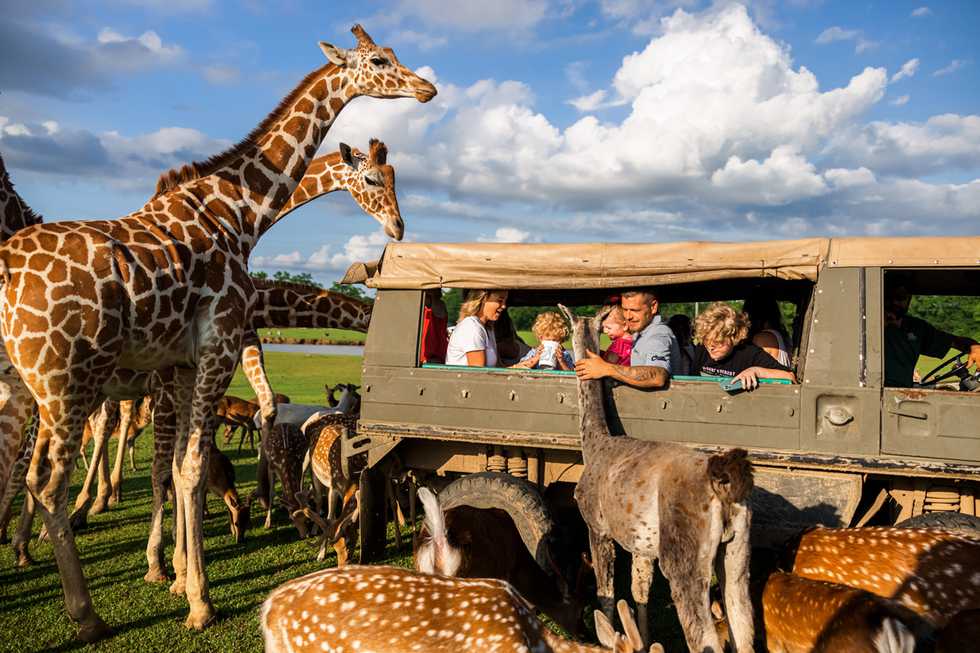
Courtesy of Global Wildlife Center
“The conservation level!” Bergmann effused. “All of these children and kids—when I’m working there two or three days in a row, and the tour bus loads go through, there's children learning about these animals and conservation and the environment. I mean, that's so valuable; it's providing something for the community, tourism, they're bringing a lot to the area, and everybody's learning. The level of education they can put out, on this massive footprint of ground, everybody can see the animals naturally … People need to know about the place, because it is amazing. It’s like Jurassic Park, I like to joke. I can drive around on my little four-wheeler ATV, I travel in there and it's like, you can drive forever looking at animals.”
While the new administration’s overhaul of Global Wildlife Center’s facility and operations has been a massive undertaking, Matherne and Cooper agree the rewards far outweigh the challenges. “Some of the most rewarding things for me have been the simple interactions I have with visitors as they return from their tour, or chatting with our staff and hearing how much they appreciate some of the changes we’re making, or getting to snuggle with one of our new baby llamas in the nursery and knowing that its future is bright,” Matherne said. “I am surrounded by the best possible team and have had huge support from the Board, friends, and family members. I could never have made it this far had it not been for my community lifting me up. I couldn’t be more proud of the strides we’ve made in just a year and I am genuinely excited as I look toward the future.”

